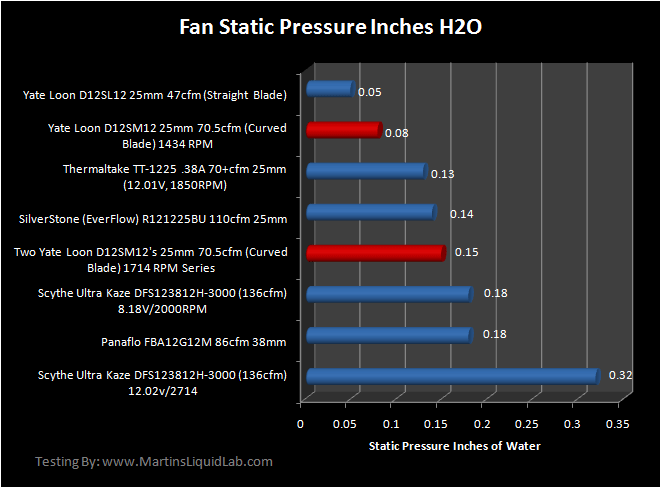

Fan Testing
Introduction
Welcome to my fan testing experiment. As many of you know, a fan operates and produces a curve that includes both pressure and flow rate almost exactly like a pump does. Unfortunately most fan manufacturers do not provide that fan curve, and a large majority don't even provide the static pressure specs. The air-flow spec you see is one that occurs when the fan is in open air without any restriction, so when mounted to a radiator of heatsink, the pressure resistance significantly impacts the amount of actual air flow just like water blocks do on a cooling loop. With the introduction of radiator thermal testing, I wanted to better understand fans at the same time and see if I could measure and capture some of these specifics around fan performance on a radiator.
My first adventure started simple, I wanted to see if I could measure a fan's static pressure.

First up was measuring against the one manufacturer that posts complete data, the Panaflo medium speed by panasonic.
Panaflo FBA12G12M
Measured Static Pressure: .18 -.20" H2O (Specifications .18" H2O)
Measured Power Consumption: 12.03V X .28V = 3.37 watts (Specifications 3.36 watts)
One thing that quickly became apparent was that my manometer the Dwyer 476A was not quite as sensetive as I had hoped. For some reason pressure measurements between -.10 to .10 want to read zero, so I had to force an error in the zero reading and do the math just to complete my static testing. In the end I decided to order another pressure guage. I ordered a Dwyer Magnahelic 2000-00 Differential Pressure Guage which is an extremly low pressure guage for measuring 0 to .25" water which is perfect for the medium to low speed fans.
In the mean time here are my results of fans that I had handy, I will redo these results after I get my new guage:
Fans Tested:
- Yate Loon D12SL12 Straight Blade - From NCIX.com
- Yate Loon D12SM12 Curved Blade - From Petra's Tech Shop
- Thermaltake TT-1225 - Old fan from Newegg many moons ago
- SilverSton R121224BU - Also an oldie from the egg
- Panaflo FBA12G12M - From SVC

What is interesting to me is two things. First 38mm are far superior in pressure. The 86cfm panaflos and Ultra Kazes @ 2000 RPM have superior pressure over the SilverStone even though they operate at a lower RPM and have lower CFM ratings. Second is I ran one experiment with stacking two Yate Loon medium speeds and nearly doubled the static pressure.
This would indicate that stacking of 25mm fans is a good means to adding static pressure, and also that you're better off with some lower speed 38mm fans instead of 25mm types.
I wanted to take this testing a step further and see if I could plot a full curve with the setup below, unfortunately I'm finding that a 2" ID globe valve and the anemometer is far too restrictive. Even with the valve open fully, I'm already restricting the fan down to about 1/2 of it's rated CFM, so this setup could only capture the first half of the performance curve and I'll need to rethink my approach to testing. Oh well, good thing I went with the cheap $12 PVC valve instead of the $35 brass one I wanted to get..:)

Fan testing sponsored by:

